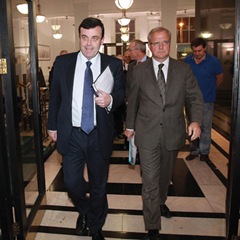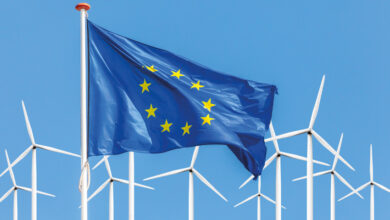The route to bailout
 As Ireland accepts international support, Eamon Quinn analyses how we got here.
As Ireland accepts international support, Eamon Quinn analyses how we got here.
Bailout as a word has its uses to describe the humiliation a government faces when it has to go cap in hand to an emergency international agency for funds. It describes fairly well the ignominy that faces an administration when foreigners will not lend it the money to run the state. But as a term it is inappropriate because it also suggests that citizens are being somehow subsidsed by others.
In so called national bailouts, nothing could be further from the truth: bailouts are costly affairs and come with huge penalties for states. Aid donors want to get their money back and, like any lender, will load costs through penal interest rates that ensure that citizens pay back the money. In short, there is no such thing as a free bailout.
At the time of writing, the Government was still resisting making a request to its euro zone partners for some sort of aid. But the international markets had long decided that the game was up, having determined that Ireland would need some sort of emergency funding to tie it over for a number of years before willingly lending the money again by buying Irish sovereign bonds.
Withdrawing from the sovereign bonds markets is not an action that any government does lightly – access by a state to the debt markets is the source of economic sovereignty. Yet, after canceling the monthly debt auctions of new bond debt paper, the authorities here continued for some time to suggest that they had voluntarily withdrawn from the markets. The government talked about “irrational markets” and “thin markets” to suggest that it was a master of its destiny. Government politicians then endlessly repeated the line that the state did not need immediate access to the new money of foreigners because, in its wisdom, it had raised dollops of money that would last through to next summer.
As a financial journalist who had worked for US news wires in the past, covering the sovereign bond markets out of London, the explanations became increasingly strange. The phrases were endlessly repeated for the purposes of the domestic media. The sense of unreality deepened because in contrast, the foreign business press, in particular columnists and editorials in the Financial Times, were increasingly sceptical of the claims being made by the Dublin authorities. On the day the annual interest rate for Ireland to borrow new money for ten years soared to a record 9.2 per cent, the Wall Street Journal published two major articles that expressed clearly the predicament: ‘Ireland’s Fate Tied’ to Doomed Banks and ‘How Did Ireland Go So Wrong?’
More importantly, the markets had completely lost faith months earlier. The interest rates the markets demanded Ireland pay for the best part of the year were the second highest in Europe after those of Greece. Each successive crisis led to a spike in Irish sovereign rates. The interest rates would fall back a little but settle at still elevated levels.
Then in May, Athens acknowledged it had lost hope of raising the €8.5 billion it needed to refinance bonds that had fallen due for repayment. It was forced to use a specially commissioned bailout fund amounting to €110 billion, which it could tap for three years, paid for by its fellow euro zone countries, including Ireland. Significantly, the IMF committed to cover about a third of the borrowings that Athens would be forced to repay at an annual interest rate of 5 per cent. For the first time, the board of an international fund based in Washington would have a say in the running of a euro zone state, such was the seriousness of the still unresolved debt crisis to Europe and the world economy.
The Irish government responded by continuing a tried and tested policy of pre-funding its budget deficits, raising more new (most expensive short-term) money than it immediately needed to fill the annual €20 billion spending gap or to cover existing bond debts as they came due for repayment. Nonetheless the markets became even edgier. The government was starting to face the reality that foreigners would never risk lending the state new money by buying our sovereign bonds. Announcing the cancellation of debt auctions in October was a clear admission.
More than anything, bond markets feared that more hidden debts in the Dublin banks would add to the big debt burden already facing Irish taxpayers. For weeks, ever since Ireland dropped out of the auctions, bond experts around Europe were saying that Ireland was heading into a bailout.
By early November the so-called credit default swap markets – the insurance markets that holders of sovereign bond debts use to insure against the risk they will get back less than they loaned out to states – were suggesting that Irish bonds were too hot to handle. The cost of insuring Irish sovereign debt in quick time became the fifth most expensive to insure in the world. The government’s strategy had become unstuck.
The source of the funds that Ireland will tap remains unclear at the time of writing. There are three bailout pots available for rich states like Ireland that Minister for Finance Brian Lenihan can call on. The first is the International Monetary Fund – the Washington-based fund that has become synonymous with bailouts. It was the route available for Britain when it was forced to seek its bailout in the mid-1970s.
These days the European states have two other alternatives: the €60 billion cash the European Commission has made available, with comparatively few complications, for EU states to tap in emergency, and the €440 billion fund set up solely for the 16 euro zone countries, the so-called European Financial Stability Facility (EFSF). It was established as a separate fund to the funds the European Central Bank/IMF supplied to Athens in May. Based in Luxembourg, the EFSF is headed by Klaus Regling, the former EC official who as co-author the report published last summer on the Irish banking implosion knows his way around Dublin. The IMF has a third share in the EFSF, and would automatically have a big say in the running of a state that taps its money.
Germany and France, the main contributors to the EFSF, may decide that the fund only contributes a small part to any bailout. The facility works by sanctioning the German Debt Agency (the equivalent of the National Treasury Management Agency) to issue bailout bonds that are then sold to investors, with the cost of course to be paid by a recipient country.
Whatever the bailout pot the European officials decide, the cost will be picked up by the recipient state. There is indeed no such thing as a free bailout.





